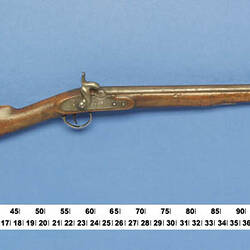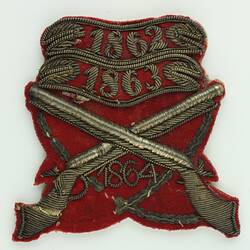Summary
British Service percussion carbine, Paget 1847 Cavalry Carbine, cal. .660 in., steel smoothbore round barrel, 458 mm long.
One of 26 guns donated in 1871 by the Victorian Ordnance Department from its Melbourne Armoury, for the newly created Industrial and Technological Museum. The display was intended to show mechanics and gunsmiths the principles of gun construction and recent technical developments in weapons.
Physical Description
Steel lock and hammer on R.H. side, brass oval triggerguard with finial front spur, steel saddle bar and ring on L.H.side, brass foreend and butt plate. Post foresight, no rear sight, barrel fastened to stock via two barrel pins, steel swivel ramrod and two brass ramrod tubes, the front one being trumpet shaped. Crudely cut 'H' into stock behind barrel tang.
Significance
An attempt to make use of parts in still in stock originally produced for the Paget Carbine of 1808 saw the development of the 1847 Paget Carbine. While the original 1808 model has been a flintlock firearms, the 1847 Carbine saw parts either converted to percussion, or in many cases simply produced new as percussion firearms, drawing on older surplus components where possible. Like most 'cavarly' firearms, the 1847 Paget employs a swivel ramrod to ensure the ramrod is not lost from horseback in the process of loading and is fitted with a saddle bar and ring on the R.H.side for use with a shoulder strap from horseback. Some Paget carbines were later rifled with Minie rifling to produce the 1852 Paget Rifled Carbine.
More Information
-
Collecting Areas
-
Acquisition Information
Donation from Melbourne Armoury, 24 Oct 1871
-
User
Victoria: Ordnance Branch, Melbourne, Greater Melbourne, Victoria, Australia, 1850s-1860s
-
Inscriptions
Stamped on lockplate: TOWER/ PROOF, crown Stamped on barrel top L.H.side with Birmingham proof and view mark. Stamped on stock R.H.side: 4, 4 Cut into stock behind tang: H
-
Model Name or Number
-
Brand Names
-
Classification
-
Category
-
Discipline
-
Type of item
-
Overall Dimensions
85.7 cm (Length), 6.5 cm (Width), 20.2 cm (Height)
Barrel length: 45.80cm
-
References
[Book] Penrose, Edgar H. 1949. Descriptive Catalogue of the Collection of Firearms in the Museum of Applied Science of Victoria. 161. 14.
-
Keywords
Rifles & Muskets: British, Rifles & Muskets: Military, Victorian Colonial Defence Forces




